Complete text and all illustrations for the monograph [1e] by Dr Jan Pajak,
"Advanced Magnetic Propulsion Systems" (1990, ISBN 0-9597698-9-7)
Links to illustrations and related texts:
Labels: The label "E" marks the web page with text of English-language version of this monograph.
The label "1st, 2nd, 3rd Figures" mark the web pages with illustrations for subsequent volumes and chapters.
The label "P" marks the web page with text of a Polish-language equivalent of this monograph.
The label "X" marks the web page with the text of English-language version of this monograph
which is designed so as to load much faster because it does NOT show graphics at the loading
stage but only after the user clicks on subsequent Figures to display them.
Chapter F:
 [1e] Figure F1: The evolution of the Oscillatory Chamber. [1e] Figure F1: The evolution of the Oscillatory Chamber.
 [1e] Figure F2: The appearence of the Oscillatory Chamber. [1e] Figure F2: The appearence of the Oscillatory Chamber.
 [1e] Figure F3: The neutralization of the electro-magnetic forces. [1e] Figure F3: The neutralization of the electro-magnetic forces.
 [1e] Figure F4: The "twin-chamber-capsule" composed of two Oscillatory Chambers located one inside of the other. [1e] Figure F4: The "twin-chamber-capsule" composed of two Oscillatory Chambers located one inside of the other.
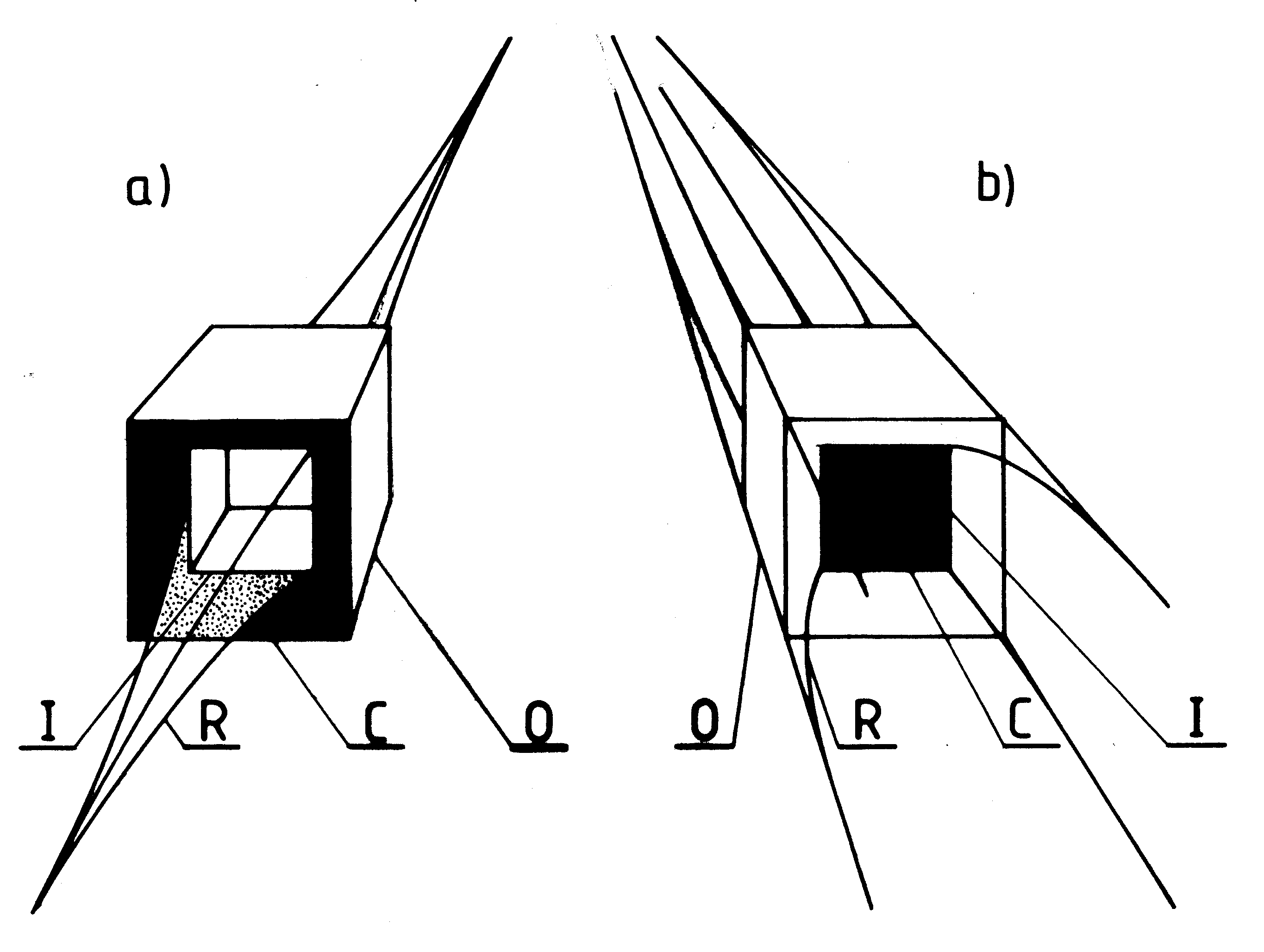 [1e] Figure F5: Appearances if two twin-chamber capsules working in two different modes of operation. [1e] Figure F5: Appearances if two twin-chamber capsules working in two different modes of operation.
 [1e] Figure F6: Outputs from both chambers of a "twin-chamber capsule". [1e] Figure F6: Outputs from both chambers of a "twin-chamber capsule".
 [1e] Figure F7: An arrangement of oscillatory chambers called "spider configuration". [1e] Figure F7: An arrangement of oscillatory chambers called "spider configuration".
 [1e] Figure F8: The curve of the "interaction in equilibrium". [1e] Figure F8: The curve of the "interaction in equilibrium".
 [1e] Figure F9 (a): Working model of the chamber in darkness. [1e] Figure F9 (a): Working model of the chamber in darkness.
 [1e] Figure F9 (b): Photograph of an experimental station for constructing an Oscillatory Chamber. [1e] Figure F9 (b): Photograph of an experimental station for constructing an Oscillatory Chamber.
 [1e] Figure F10: The justification for needle-shaped electrodes. [1e] Figure F10: The justification for needle-shaped electrodes.
Chapter H:
 [1e] Figure H1 (a): The Magnocraft and the personal propulsion system. (a) Magnocraft type K3 in hanging position. [1e] Figure H1 (a): The Magnocraft and the personal propulsion system. (a) Magnocraft type K3 in hanging position.
 [1e] Figure H1 (b): The propelling system in personal propulsion. [1e] Figure H1 (b): The propelling system in personal propulsion.
 [1e] Figure H2: The standard personal propulsion garment. [1e] Figure H2: The standard personal propulsion garment.
 [1e] Figure H3 (left): External forces acting in a personal propulion system. [1e] Figure H3 (left): External forces acting in a personal propulion system.
 [1e] Figure H3 (right): Internal forces in personal propulsion (they explain the frequent flight of UFOnauts in a squat position). [1e] Figure H3 (right): Internal forces in personal propulsion (they explain the frequent flight of UFOnauts in a squat position).
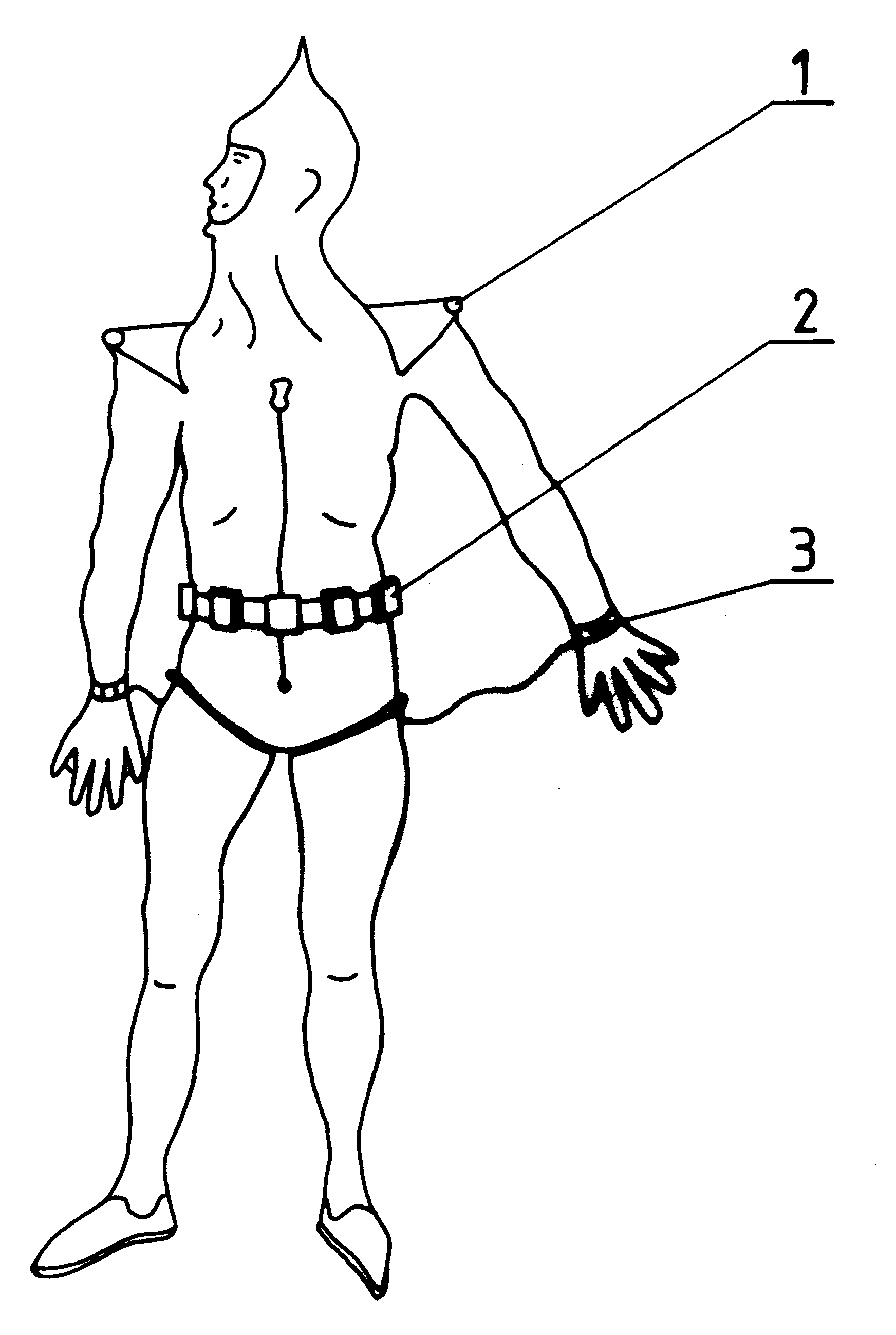 [1e] Figure H4 (a): personal propulsion with propulsors in epolettes. [1e] Figure H4 (a): personal propulsion with propulsors in epolettes.
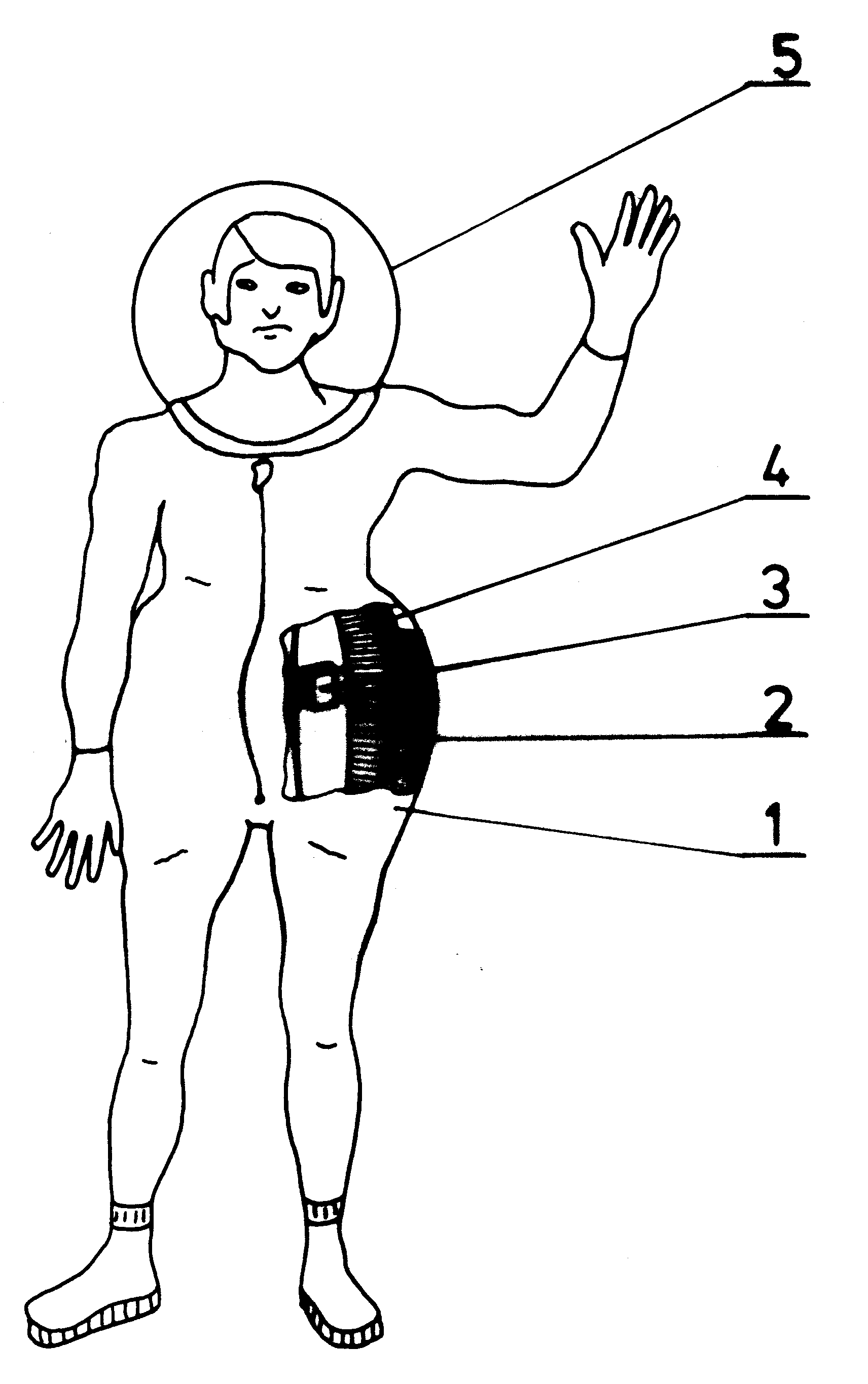 [1e] Figure H4 (b): personal propulsion with helmet and cushions around hips. [1e] Figure H4 (b): personal propulsion with helmet and cushions around hips.
Chapter I:
 [1e] Figure I1: A four-propulsor Magnocraft. [1e] Figure I1: A four-propulsor Magnocraft.
 [1e] Figure I2: Propulsors in a four-propulsor Magnocraft of the first generation. [1e] Figure I2: Propulsors in a four-propulsor Magnocraft of the first generation.
Chapter J:
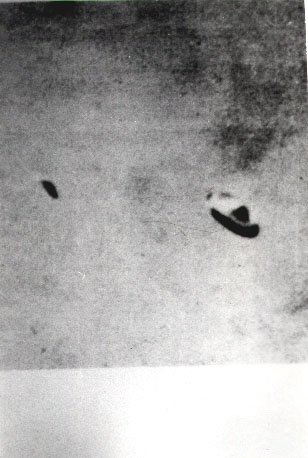 [1e] Figure J1: Comparison of Magnocraft type K3 and a UFO type K3. A photograph of a UFO type K3. [1e] Figure J1: Comparison of Magnocraft type K3 and a UFO type K3. A photograph of a UFO type K3.
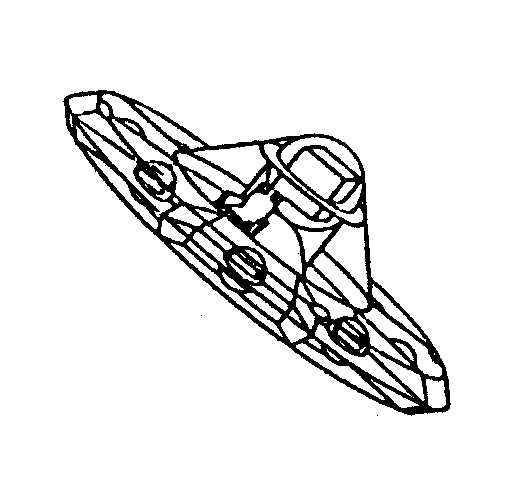 [1e] Figure J1 (framed): A drawing of Magnocraft type K3 in the sdame position as that UFO. [1e] Figure J1 (framed): A drawing of Magnocraft type K3 in the sdame position as that UFO.
 [1e] Figure J2: A UFO typer K5 by Ralph Ditter over Zanesville. Note outlines of the vehicle's flange revealed by the line of shade. [1e] Figure J2: A UFO typer K5 by Ralph Ditter over Zanesville. Note outlines of the vehicle's flange revealed by the line of shade.
 [1e] Figure J3: A UFO taken by George Stock, Passaic. [1e] Figure J3: A UFO taken by George Stock, Passaic.
 [1e] Figure J4: A cigar-shaped UFO taken from above by Inake Oses. [1e] Figure J4: A cigar-shaped UFO taken from above by Inake Oses.
 [1e] Figure J5 (a): Frame no 9 of a K4 UFO by Rudi Nagora. A whole photo. [1e] Figure J5 (a): Frame no 9 of a K4 UFO by Rudi Nagora. A whole photo.
 [1e] Figure J5 (b): Rudi's Nagora enlargement of the vehicle.. [1e] Figure J5 (b): Rudi's Nagora enlargement of the vehicle..
 [1e] Figure J6: A K8 UFO from Grenoble, France. [1e] Figure J6: A K8 UFO from Grenoble, France.
 [1e] Figure J7 (a): A K9 UFO, Edwards Air Force Base, USA. A whole photograph. [1e] Figure J7 (a): A K9 UFO, Edwards Air Force Base, USA. A whole photograph.
 [1e] Figure J7 (b): The enlargement of the UFO vehicle. [1e] Figure J7 (b): The enlargement of the UFO vehicle.
 [1e] Figure J8 (a): A K10 UFO over Bara de Tijuca, Brasil. A whole photograph. [1e] Figure J8 (a): A K10 UFO over Bara de Tijuca, Brasil. A whole photograph.
 [1e] Figure J8 (b): An enlargement of the Bara de Tijuca UFO type K10. [1e] Figure J8 (b): An enlargement of the Bara de Tijuca UFO type K10.
 [1e] Figure J9: The so-called Yorba Linda UFO photo. [1e] Figure J9: The so-called Yorba Linda UFO photo.
 [1e] Figure J10: The table of UFO shapes compiled by Knut Aasheim. [1e] Figure J10: The table of UFO shapes compiled by Knut Aasheim.
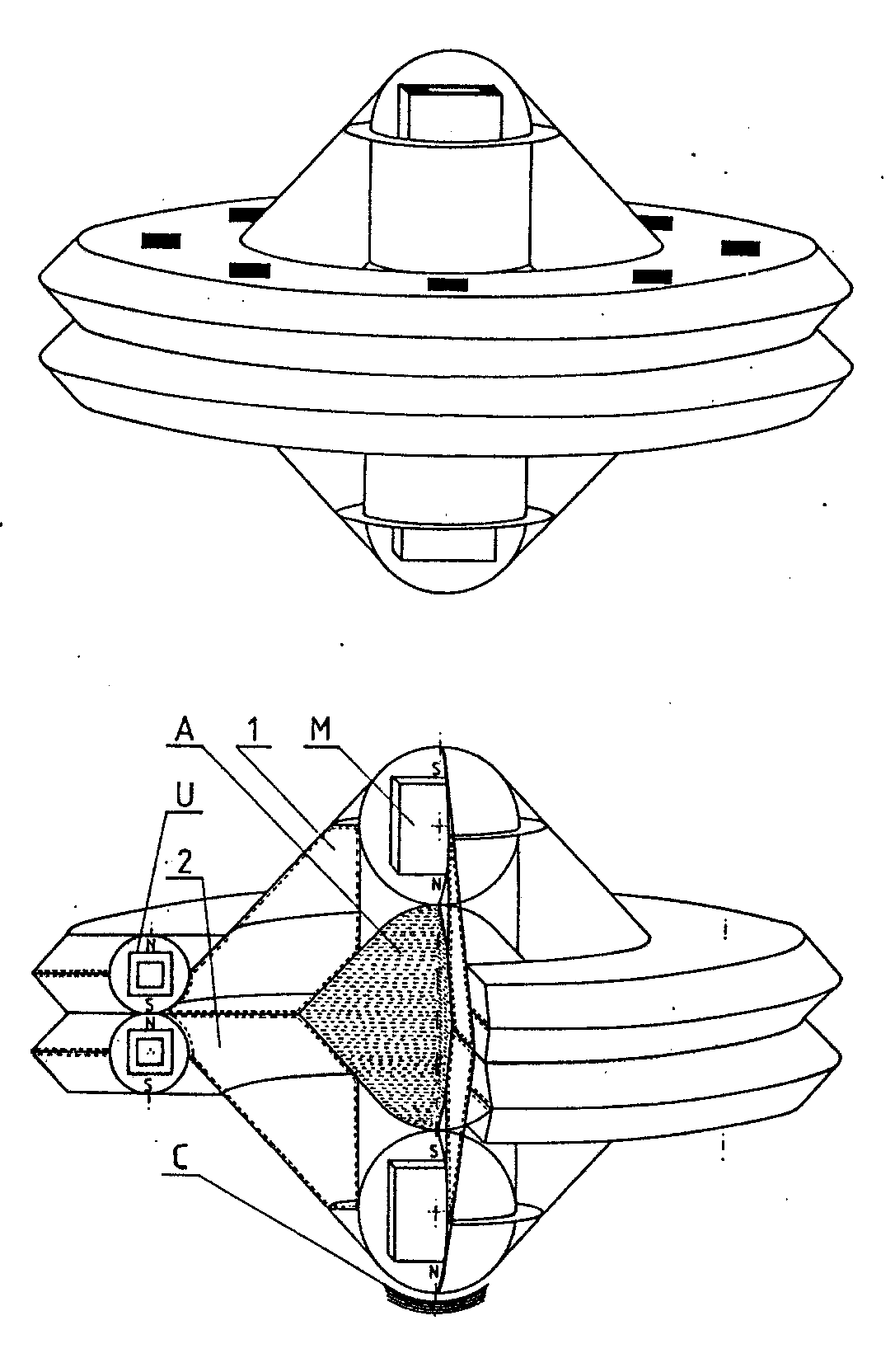 [1e] Figure J11: Spherical flying complex of two UFOs type K6. Shown are side appearences of such a spherical flying complex, but composed of two Magnocraft type K3. [1e] Figure J11: Spherical flying complex of two UFOs type K6. Shown are side appearences of such a spherical flying complex, but composed of two Magnocraft type K3.
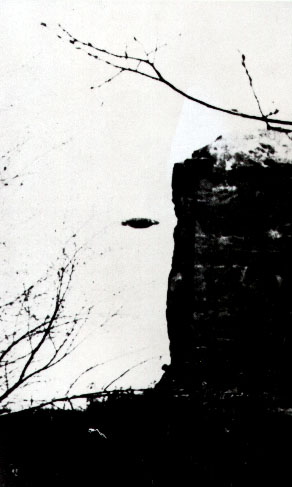 [1e] Figure J11 (a): Photograph of Thorns spherical UFO type K6. [1e] Figure J11 (a): Photograph of Thorns spherical UFO type K6.
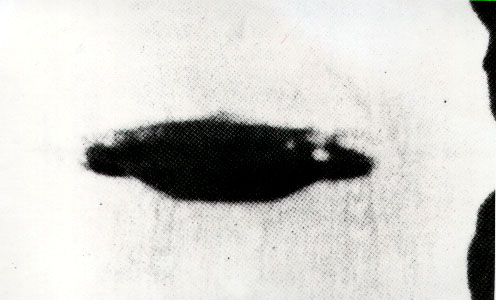 [1e] Figure J11 (b): Enlargement of UFOs from Thorns photo. [1e] Figure J11 (b): Enlargement of UFOs from Thorns photo.
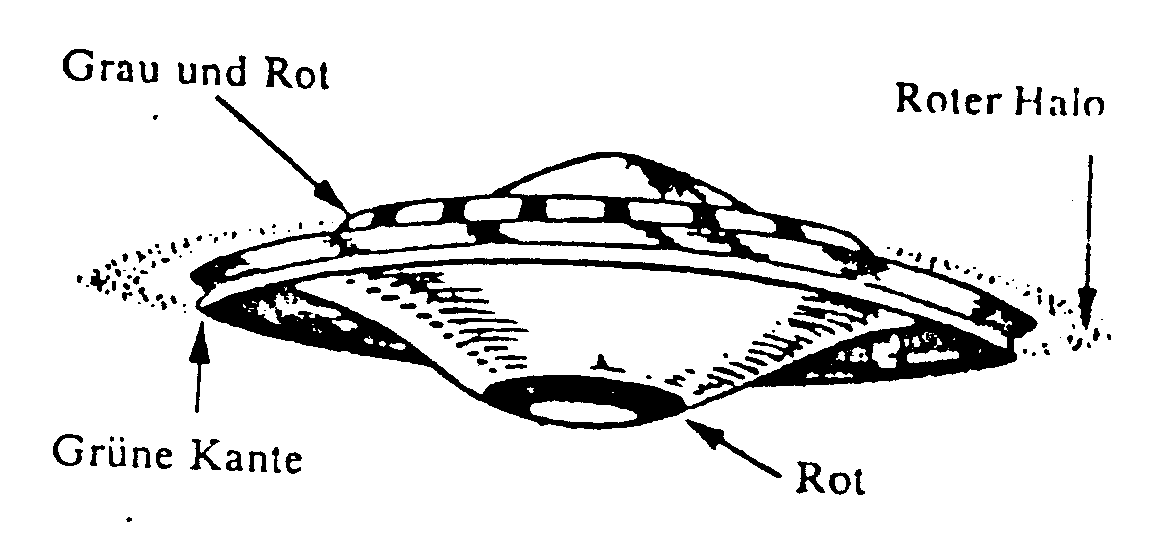 [1e] Figure J11 (c): Shape of Thorns UFO in GICOFF reconstruction. [1e] Figure J11 (c): Shape of Thorns UFO in GICOFF reconstruction.
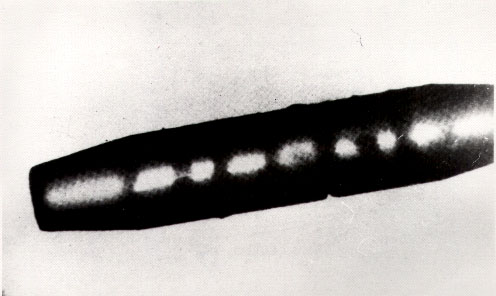 [1e] Figure J12 (a): Cigar-shaped UFO from Palomar Gardens, 1952. [1e] Figure J12 (a): Cigar-shaped UFO from Palomar Gardens, 1952.
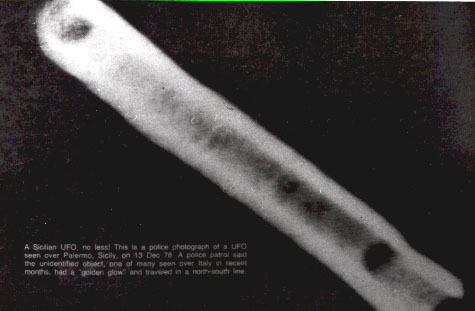 [1e] Figure J12 (b): Cigar-shaped UFO from Palermo, Sicily, 1978. [1e] Figure J12 (b): Cigar-shaped UFO from Palermo, Sicily, 1978.
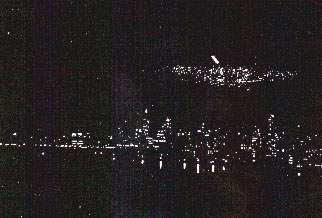 [1e] Figure J12 (c): Cigar-shaped UFO above New York, 1950. [1e] Figure J12 (c): Cigar-shaped UFO above New York, 1950.
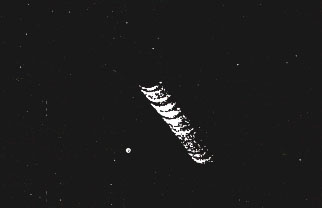 [1e] Figure J12 (d): An enlargement of the cigar-shaped UFO from New York shown in part (c). [1e] Figure J12 (d): An enlargement of the cigar-shaped UFO from New York shown in part (c).
 [1e] Figure J13 (a): A fir-tree UFO drawn by Mrs. Hewison of Wales, UK. [1e] Figure J13 (a): A fir-tree UFO drawn by Mrs. Hewison of Wales, UK.
 [1e] Figure J13 (b): The UFO drawn by Mrs W., Tasmania, Australia. [1e] Figure J13 (b): The UFO drawn by Mrs W., Tasmania, Australia.
 [1e] Figure J14: A detached configuration of two K3 type UFOs. [1e] Figure J14: A detached configuration of two K3 type UFOs.
 [1e] Figure J15: The so-called Oregon UFO. [1e] Figure J15: The so-called Oregon UFO.
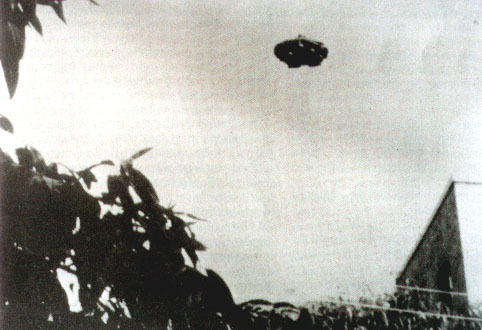 [1e] Figure J16: A carrier platform over New Jersey, USA. [1e] Figure J16: A carrier platform over New Jersey, USA.
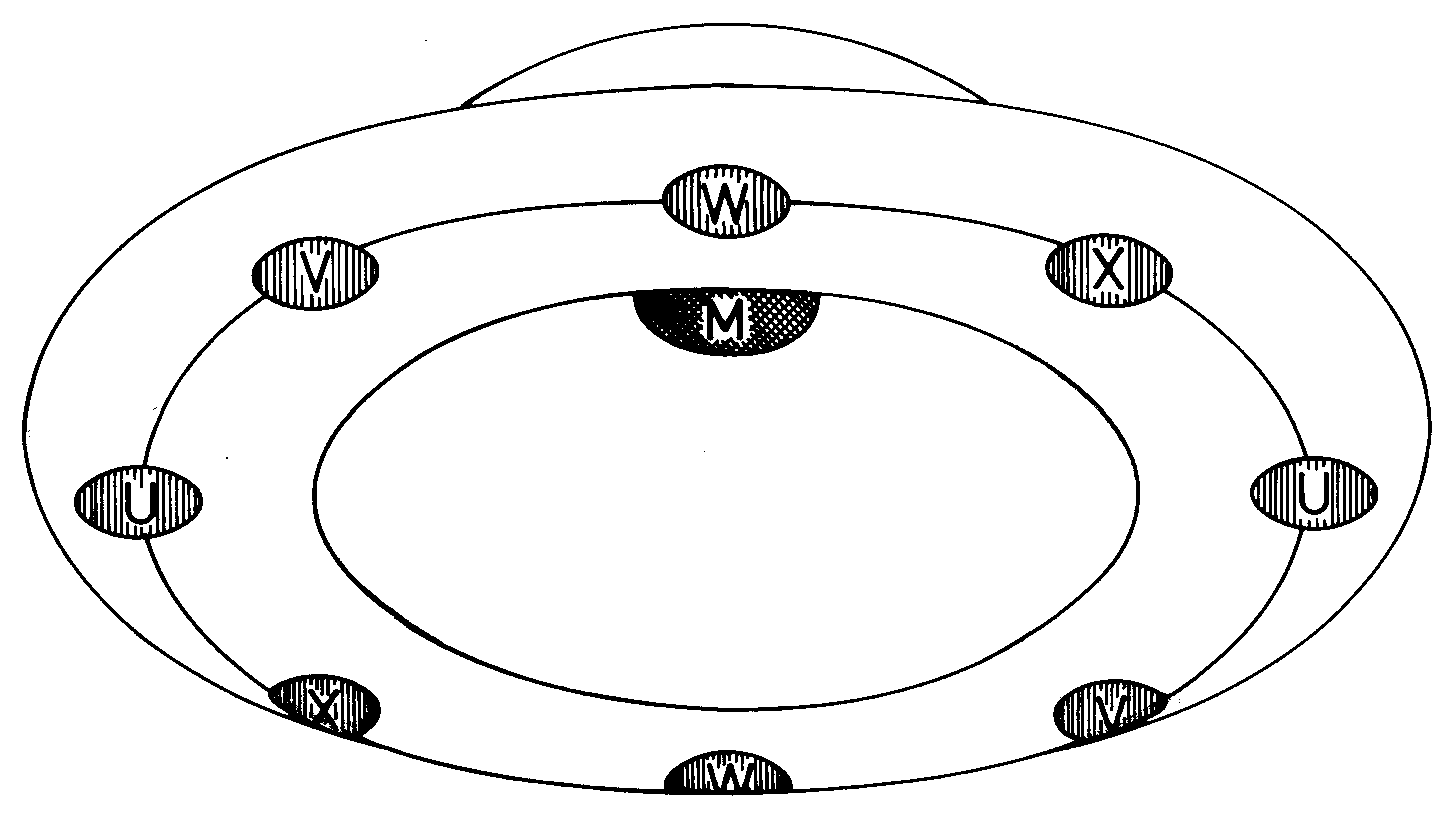 [1e] Figure J17 (A): The location of propulsors in UFOs and Magnocraft. Magnocraft type K3 propulsors shown from below. [1e] Figure J17 (A): The location of propulsors in UFOs and Magnocraft. Magnocraft type K3 propulsors shown from below.
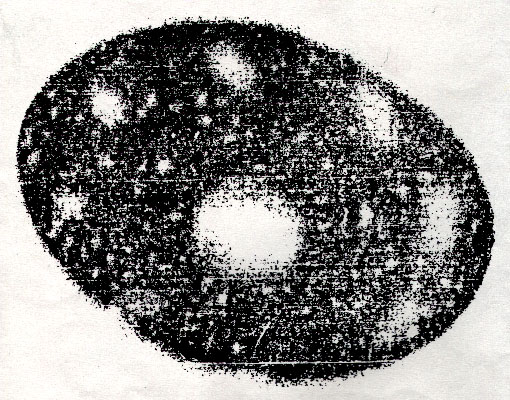 [1e] Figure J17 (B): Photo of a UFO type K3 from below, that reveals the location of vehicle's magnetic propulsors. [1e] Figure J17 (B): Photo of a UFO type K3 from below, that reveals the location of vehicle's magnetic propulsors.
 [1e] Figure J18: The Motunau Beach UFO, New Zealand. [1e] Figure J18: The Motunau Beach UFO, New Zealand.
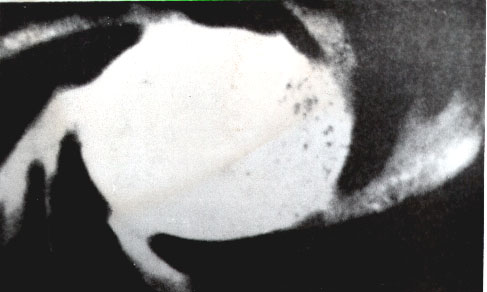 [1e] Figure J19: Fragment of UFO magnetic circuits just around the main propulsor, taken from below. [1e] Figure J19: Fragment of UFO magnetic circuits just around the main propulsor, taken from below.
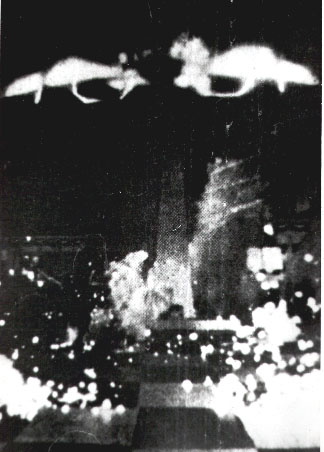 [1e] Figure J20: Side photograph of UFOs, which illustrate the course of their magnetic circuits. [1e] Figure J20: Side photograph of UFOs, which illustrate the course of their magnetic circuits.
 [1e] Figure J21: Photographs of UFOs documenting the pulsations of their magnetic field. Principles involved in photographing of field pulses in fast moving UFOs. [1e] Figure J21: Photographs of UFOs documenting the pulsations of their magnetic field. Principles involved in photographing of field pulses in fast moving UFOs.
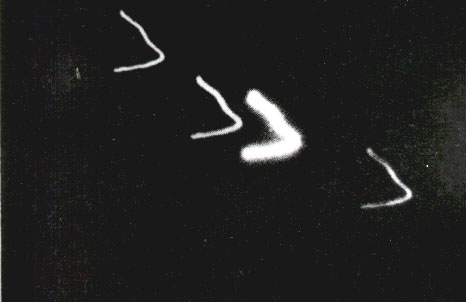 [1e] Figure J21 (a): Fast flying UFO from Chamberlain. Pulses in ionised air are clearly visible. [1e] Figure J21 (a): Fast flying UFO from Chamberlain. Pulses in ionised air are clearly visible.
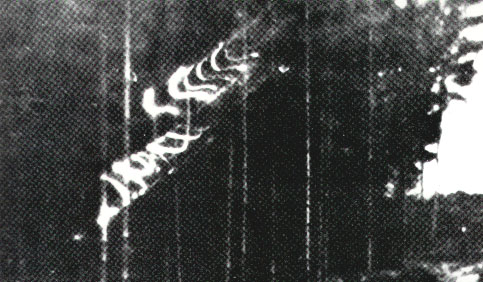 [1e] Figure J21 (b): Pulsating UFO of Karl Maier taken in 1962. [1e] Figure J21 (b): Pulsating UFO of Karl Maier taken in 1962.
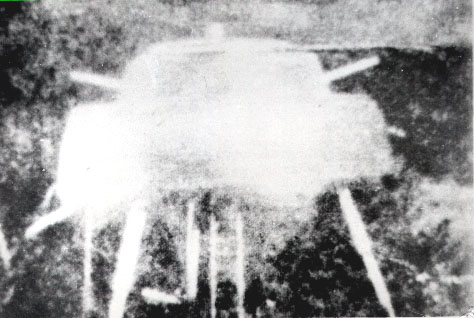 [1e] Figure J22: A landed UFO at night in Genui, Italy. It shows a jonic picture of the magnetic whirl. [1e] Figure J22: A landed UFO at night in Genui, Italy. It shows a jonic picture of the magnetic whirl.
 [1e] Figure J23 (a): Two ionic pictures of a UFO magnetic whirl. (a) A K7 UFO by Paul Trent. [1e] Figure J23 (a): Two ionic pictures of a UFO magnetic whirl. (a) A K7 UFO by Paul Trent.
 [1e] Figure J23 (b): (b) A K8 UFO by a pilot over Rouen, France. [1e] Figure J23 (b): (b) A K8 UFO by a pilot over Rouen, France.
 [1e] Figure J24 (a): An extremely fast UFO by Mrs Edwards B. (a) The entire frame. [1e] Figure J24 (a): An extremely fast UFO by Mrs Edwards B. (a) The entire frame.
 [1e] Figure J24 (b): (b) The bow-up of the flying UFO. [1e] Figure J24 (b): (b) The bow-up of the flying UFO.
 [1e] Figure J25: A night photo of a UFO over Tulsa. [1e] Figure J25: A night photo of a UFO over Tulsa.
 [1e] Figure J26: A night UFO over Kaikoura, New Zealand. [1e] Figure J26: A night UFO over Kaikoura, New Zealand.
 [1e] Figure J27: A UFO hidden behind a magnetic lens. [1e] Figure J27: A UFO hidden behind a magnetic lens.
 [1e] Figure J28: A K5 UFO at night in the throbbing operation. [1e] Figure J28: A K5 UFO at night in the throbbing operation.
 [1e] Figure J29: A night photo of a K3 UFO with a searchlight. [1e] Figure J29: A night photo of a K3 UFO with a searchlight.
 [1e] Figure J30: A K7 UFO over San Jose de Valderas (Spain). [1e] Figure J30: A K7 UFO over San Jose de Valderas (Spain).
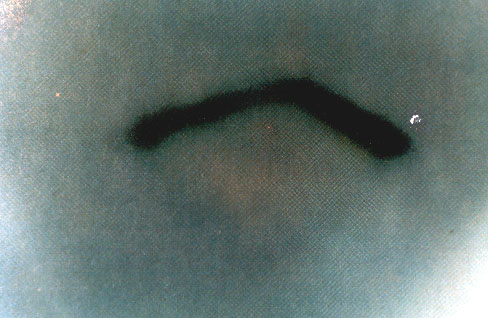 [1e] Figure J31: Colour photo of a UFO capsule of 1st generation [1e] Figure J31: Colour photo of a UFO capsule of 1st generation
 [1e] Figure J32 (a): An unjustified claim hoaxing a genuine UFO photograph. (a) an original photograph of K7 UFO spain - see [1e] Figure J30. [1e] Figure J32 (a): An unjustified claim hoaxing a genuine UFO photograph. (a) an original photograph of K7 UFO spain - see [1e] Figure J30.
 [1e] Figure J32 (b): (b) A computer "undisputed proof" of the supposed hoax (this computer image simply reveals the course of the vehicle's main magnetic circuit). [1e] Figure J32 (b): (b) A computer "undisputed proof" of the supposed hoax (this computer image simply reveals the course of the vehicle's main magnetic circuit).
 [1e] Figure J33 (top): UFOs by C.R. Hart, Jr. above Lubbock, Texas. (top) Disk-shaped vehicles. [1e] Figure J33 (top): UFOs by C.R. Hart, Jr. above Lubbock, Texas. (top) Disk-shaped vehicles.
 [1e] Figure J33 (bottom): (bottom) Shoe-shaped vehicles. [1e] Figure J33 (bottom): (bottom) Shoe-shaped vehicles.
 [1e] Figure J34: Deductions by Renato Vesco about Lubbock photos. It proves that shoe-shaped photos simply show the trail of plasma ionised by vehicle's magnetic field. [1e] Figure J34: Deductions by Renato Vesco about Lubbock photos. It proves that shoe-shaped photos simply show the trail of plasma ionised by vehicle's magnetic field.
Chapter K:
 [1e] Figure K1 (a): The "Devil Stone" from Zemanow near Milicz, Poland. This photograph was taken by O. Stahr in 1912. It is reproduced from the German Journal "Heimat Blätter für ben Kreis Militsch Trachenberg", no. 2/1925, page 12. The photo was accompanied with the following legend, quote (after my translation into English): "The devil was furious because citizens of Trzebicko village were planning to build a church. He decided to destroy the construction which had just been started. One pitch black night he picked up a huge stone in his hand and flew in the direction of Trzebicko in order to smash the church. However the strong westerly wind impeded his flight. He had only just reached a place where the village of Zemanňw now stands, when the first rays of the rising sun appeared and a rooster began to crow. The devil had to drop the stone and then flew back to where he came from.
On the surface of the stone was left the impression of a large clawed paw."
More details about the devil stone from Zemanów is provided on a separate web page, which in "Menu 2" and "Menu 4" is named
Milicz. [1e] Figure K1 (a): The "Devil Stone" from Zemanow near Milicz, Poland. This photograph was taken by O. Stahr in 1912. It is reproduced from the German Journal "Heimat Blätter für ben Kreis Militsch Trachenberg", no. 2/1925, page 12. The photo was accompanied with the following legend, quote (after my translation into English): "The devil was furious because citizens of Trzebicko village were planning to build a church. He decided to destroy the construction which had just been started. One pitch black night he picked up a huge stone in his hand and flew in the direction of Trzebicko in order to smash the church. However the strong westerly wind impeded his flight. He had only just reached a place where the village of Zemanňw now stands, when the first rays of the rising sun appeared and a rooster began to crow. The devil had to drop the stone and then flew back to where he came from.
On the surface of the stone was left the impression of a large clawed paw."
More details about the devil stone from Zemanów is provided on a separate web page, which in "Menu 2" and "Menu 4" is named
Milicz.
 [1e] Figure K1 (b): The wooden church in Trzebicko near Milicz, Poland. It is this church to which, according to the legend, the devil carried the Zemanów's stone. The first historic mention of this church is dated 1571.
More details on this wooden church from Trzebicko is provided on a separate web page, which in "Menu 2" and "Menu 4" is named
Milicz. [1e] Figure K1 (b): The wooden church in Trzebicko near Milicz, Poland. It is this church to which, according to the legend, the devil carried the Zemanów's stone. The first historic mention of this church is dated 1571.
More details on this wooden church from Trzebicko is provided on a separate web page, which in "Menu 2" and "Menu 4" is named
Milicz.
 [1e] Figure K1 (c): Devil's footprints on the stone from Emilcin, near Lublin, Poland. The research of the abduction of a local farmer, Jan Wolski, on 10 May 1978, revealed that a UFO crew manipulated something on this stone.
More details on this devil stone from Emilcin is provided on a separate web page, which in "Menu 2" and "Menu 4" is named
Milicz. [1e] Figure K1 (c): Devil's footprints on the stone from Emilcin, near Lublin, Poland. The research of the abduction of a local farmer, Jan Wolski, on 10 May 1978, revealed that a UFO crew manipulated something on this stone.
More details on this devil stone from Emilcin is provided on a separate web page, which in "Menu 2" and "Menu 4" is named
Milicz.
 [1e] Figure K1 (d): The stone footprint in Addingham High Moor, UK. [1e] Figure K1 (d): The stone footprint in Addingham High Moor, UK.
 [1e] Figure K2 (High): The extraction glow emitted from a Devil Stone - front view. [1e] Figure K2 (High): The extraction glow emitted from a Devil Stone - front view.
 [1e] Figure K2 (Low): Extraction glow from a Devil Stone - side view. [1e] Figure K2 (Low): Extraction glow from a Devil Stone - side view.
 [1e] Figure K3 (a): The Angel Stone from Stopka near Bydgoszcz, Poland - the general view. [1e] Figure K3 (a): The Angel Stone from Stopka near Bydgoszcz, Poland - the general view.
 [1e] Figure K3 (b): The placement of the photographjic film on this tone. [1e] Figure K3 (b): The placement of the photographjic film on this tone.
 [1e] Figure K3 (c): The emmision of the extraction glow from this stone registered on film. [1e] Figure K3 (c): The emmision of the extraction glow from this stone registered on film.
 [1e] Figure K4: UFOs of the 2nd generation with telekinetic propulsors. [1e] Figure K4: UFOs of the 2nd generation with telekinetic propulsors.
Instructions:
Part G: How to
replicate
this web page in your own computer:
For some readers that work
on problems addressed on this web page, it would be highly
beneficial to have a replica of this web page together with
all the illustrations, texts, links, etc., in their own
computer. After all, in case of having such a replica, one
can later view this web page, or print it, directly from
his/her own computer, not from the Internet. Thus one becomes
independent from the access to Internet in each situation
when he/she wishes to have a good look at this web page or
at illustrations that this page displays. Waiting for
opening a web page is then also incomparably shorter
than waiting for opening an Internet page. It is then
also not needed to put up with all these subtle obstructions
which seem to plague my web pages almost as it these are
purposely sabotaged by "little green UFOnauts" of some sort.
So for these readers, who wish to make a "source replica"
of this web page in their own computer, below I am describing
step-by-step how to accomplish this. This description reveals
thoroughloy how to prepare the so-called "source replica" of
the web page, means a replica prepared in the programming
language called "HTML" in which this web page was originally
coded. Note that such a "source replica" is much better than
an "image replica" that almost every browser allows to make
in quite a simple way. For example it allows to gradually
complete all missing components of a given web page (e.g.
missing illustrations or text files) from other servers.
It alows to update separately each selected component of
the web page as soon as we meet in Internet their better
versions. It also allows us to learn principles of web
page programming, thus it can be for us a first step towards
later making our own web pages. Here is the instruction
of producing such a "source replica":
#0. Ready-made source replica?
(without advertising banners). One brief information before in items
#1 to #8 below I explain the exact procedure of preparing for yourself
a source replica of this web page. Namely, under some addresses listed
in "Menu 3", such a source replica of this web page, together with
all folders, source codes of web pages, samples of texts and illustration,
etc., but without advertising banners, already awaits in the ZIP format,
ready for downloading to your own computer. So all what you need to
do in order to download it to your own computer, is to click in
"Menu 1" on the menu item marked
"Source replica of this page".
So try to click, because this source replica may be available here
(i.e. at this address) and it would be handy to have it in your
own computer. In turn, when such a ZIPped source replica downloads
to your computer, all what you need to do is UNZIP it onto your
hard disk. After UNZIPing, it forms a separate folder in which
you will find a folder named "a_pajak" with all source files,
subfolders and samples of text and illustration inside, ready for
the running, testing, displaying, and checking how all these work
on your own computer. All what you later need to do in your spare
time is to download to text folders remaining volumes of monograph
[1/4], while to folder 14 download the remaining illustrations,
which could not be included to the ready-made source replica
because of their volume. (Note that in case you already have on your
hard disk a folder named "c:\a_pajak" with
my other source web pages, it is enough if you transfer all files and
subfolders from this new folder "a_pajak" to the already existing one
named "c:\a_pajak".) After this brief information, let us now return
to this procedure of making (all by yourself) a source replica of this
web page. Here it is:
#1. Create a folder
named "a_pajak" (or "archives_pajak") on your hard disk "c:".
This folder is to hold this web page (and possibly also any
other my web pages). To create such a folder, run a utility
program named "Windows Explorer" or "My Computer", choose
"Local Disk (C:)" for the "Address" in this utility program,
then click on "File" in the pull-down menu from this "Windows
Explorer", then click "New", finally choose the command "folder".
Type the name "a_pajak" to the new folder that you created
on you hard disk. Later you are to use this folder "a_pajak"
for storing all my web pages, monographs, and illustrations
that you wish to keep in you own computer.
#2. Create sub-folders
inside of this main folder named "a_pajak". These sub-folders are
to contain subsequent kinds of texts and illustrations displayed
or accessed through this web page. Here is the list of sub-folders
that are used by this web page:
14 - it contains all the illustrations which are used by
monograph [1e] (and thus also this web page), and also are used
in monograph [1/4].
54 - it contains all the illustrations which are used by
monograph [1e] (and thus also this web page), and also are used
in monograph [5/4].
flags - it contains images of flags (i.e. German, Spanish,
French, Italian, Polish, and English) used in my web pages. These
images of flags are contained in files named de_flag.gif, es_flag.gif,
fr_flag.gif, it_flag.gif, pl_flag.gif, uk_flag.gif. Any flags
scanned into "*.gif" files with the above names, can be used for
this purpose.
1e - it contains the source text of monograph [1e] in English,
plus all illustrations unique to this monograph [1e].
In order to create such sub-folders, again it is enough to shift
the "Windows Explorer" inside of the folder "a_pajak" and then
generate them one by one.
#3. Save the source code of this web page
in your folder "a_pajak". For this, "right click" on your mouse while pointing
it any text area of this web page (e.g. pointing right here). A small menu
should appear, which is to have the option "View Source". Click on this menu
option, and the source code of complete this web page appears in your text
editor named "Notepad". Click on the "File" pull-down menu from this "Notepad"
and choose the option "Save As...". Save the source code from your "Notepad"
using the name "figs_1e_2.htm" for the "File name" of this code, while for
the "Save in" pointing at the folder "c:\a_pajak" that you created earlier.
Notice that pages called via links from this page, should be saved
under slightly different names, namely:
"figs_1e_1.htm" for the page with illustrations (1),
"figs_1e_2.htm" for the page with illustrations (2),
"figs_1e_3.htm" for the page with illustrations (3).
In order to save the text of (scrollable) "Menu 4", you need to firstly
display it on the screen, by clicking on it from either "Menu 1" or "Menu 2",
and only then you can save the source code of it under the name "menu.htm"
in a manner identical as you save the source code of this web page.
Also all pages called from this page via links in "Menu 1" or "Menu 2", should
be saved almost identically as you save this web page, only that you use
slightly different names assigned to them, e.g names: "oscillatory_chamber.htm"
for the web page on the "Oscillatory Chamber", "magnocraft.htm" for the web
page on "Magnocraft", "tekst_1_4.htm" for the Polish version of this web
page, etc.
#4. Save illustrations. Right click
separately on each illustration from this web page, then choose the option
"Save Picture As". The majority of illustrations you need to save in the
subfolder "14". Remaining in subfolders [54] and [1e]. Notice that each
illustration indicates at the bottom of the screen the subfolder in which
it is to be saved.
#5. Run this web page in your computer.
After you save this web page, you can run it in your own computer whenever
you wish, by simple pointing at the file "figs_1e_2.htm" (i.e. the one with
the source code of this web page) using the "Windows Explorer" for this pointing,
and then double clicking at this file. (You can also run this file by pointing
the "Windows Explorer" at it, and then pressing "Enter".) Pages linked with this
one via hyperlinks can also be displayed through clicking on these hyperlinks
while viewing this page, or can be displayed through clicking via the "Windows
Explorer" at their names, means e.g. at "figs_1e.htm", "figs_1e_1.htm",
"figs_1e_2.htm", "figs_1e_3.htm", "oscillatory_chamber.htm", "magnocraft.htm",
"pajak_jan_uk.htm", etc.
#6. (Optionally) remove banners. Free
servers on which for the understandable reasons I display all my web sites,
usually insert codes of banners to the source code of web pages that are
displayed on them (frequently codes of these banners contain various irritating
errors which try to make viewing my web pages quite difficult). If these banners
irritate you, you can optionally cut them out from
the source code of this web page, after you save this code in your own computer.
To cut the banners out you need to identify their code (either by addresses
referred in this code and starting from "http://...", or by seeking the
comment type "banner insertion ..." which appears at the beginning and
at the end of the banners' code).
#7. (Optionally) update your replica of this
web page. If someone is especially interested in descriptions contained on this
web page, then it would be desirable to check in Internet every let say couple of
months, whether description from this web page are updated and improved. If so, then
it is worth to replace the old version of this web page with this improved version.
For this, it is enough to rename the old replica kept in your computer by adding
the word "old_" in front of it, and then copy from the internet a new version
to store it under the original name that it has.
#8. In case of any doubt regarding the making
of such a replica of this web page, it is worth to see a separate web page that is
entirely devoted to the explaination of the replication procedure of my internet
pages in your own computer. This additional web page is run from
"Menu 2",
where it is listed under the name
Replicate".
Links to illustrations and related texts:
Labels: The label "E" marks the web page with text of English-language version of this monograph.
The label "1st, 2nd, 3rd Figures" mark the web pages with illustrations for subsequent volumes and chapters.
The label "P" marks the web page with text of a Polish-language equivalent of this monograph.
The label "X" marks the web page with the text of English-language version of this monograph
which is designed so as to load much faster because it does NOT show graphics at the loading
stage but only after the user clicks on subsequent Figures to display them.
|